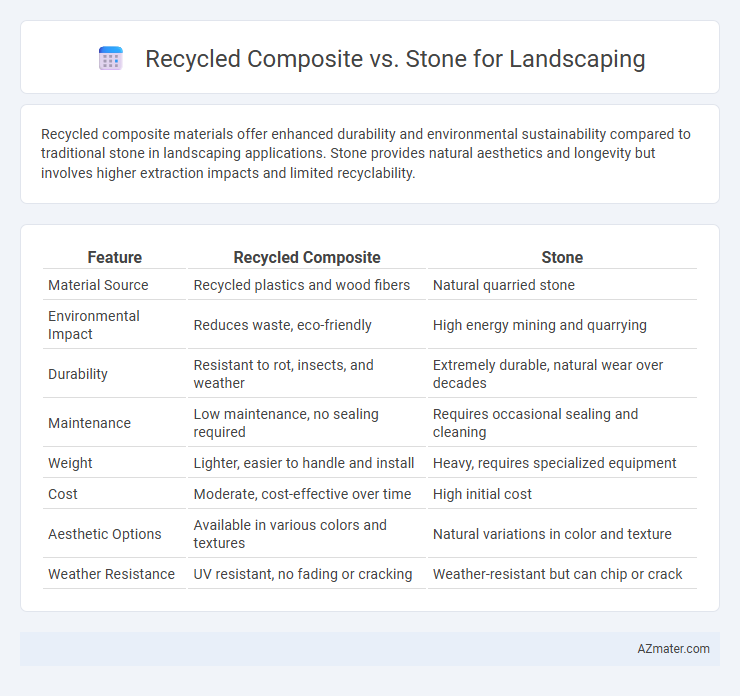Recycled composite materials offer enhanced durability and environmental sustainability compared to traditional stone in landscaping applications. Stone provides natural aesthetics and longevity but involves higher extraction impacts and limited recyclability.
Table of Comparison
| Feature | Recycled Composite | Stone |
|---|---|---|
| Material Source | Recycled plastics and wood fibers | Natural quarried stone |
| Environmental Impact | Reduces waste, eco-friendly | High energy mining and quarrying |
| Durability | Resistant to rot, insects, and weather | Extremely durable, natural wear over decades |
| Maintenance | Low maintenance, no sealing required | Requires occasional sealing and cleaning |
| Weight | Lighter, easier to handle and install | Heavy, requires specialized equipment |
| Cost | Moderate, cost-effective over time | High initial cost |
| Aesthetic Options | Available in various colors and textures | Natural variations in color and texture |
| Weather Resistance | UV resistant, no fading or cracking | Weather-resistant but can chip or crack |
Introduction to Landscaping Material Choices
Recycled composite materials offer sustainable and durable options for landscaping, made from reclaimed wood fibers and plastic, providing resistance to rot, insects, and weathering. Stone, a traditional landscaping choice, boasts natural strength, longevity, and aesthetic versatility, with types including granite, limestone, and slate commonly used in various design applications. Selecting between recycled composite and stone depends on factors such as environmental impact, maintenance requirements, and desired texture or appearance in outdoor spaces.
What Are Recycled Composites?
Recycled composites are sustainable landscaping materials made from a blend of recycled plastics and wood fibers, offering durability and resistance to moisture, insects, and decay. Unlike natural stone, recycled composites provide uniformity in texture and color while reducing environmental impact by repurposing waste materials. Their lightweight nature and ease of installation make them a practical alternative for pathways, decks, and garden edging in landscaping projects.
Understanding Natural Stone in Landscaping
Natural stone in landscaping offers unparalleled durability, timeless aesthetic appeal, and eco-friendly benefits by using a sustainable, natural resource. Its unique textures and colors create visually pleasing, customizable outdoor spaces that blend seamlessly with the environment. Stone's thermal mass also regulates soil temperature, promoting healthy plant growth and contributing to long-term landscape sustainability.
Durability: Recycled Composite vs Stone
Recycled composite materials offer superior durability in landscaping applications due to their resistance to moisture, insects, and rot compared to natural stone, which can be prone to cracking and weathering over time. Stone provides exceptional hardness and longevity under heavy foot traffic and extreme weather conditions but may require sealing to prevent erosion and surface degradation. Choosing between recycled composite and stone depends on the specific environmental factors and maintenance preferences, with composites excelling in low-maintenance durability and stone delivering enduring natural strength.
Environmental Impact and Sustainability
Recycled composite materials in landscaping significantly reduce landfill waste by repurposing industrial byproducts and plastics, lowering carbon footprints compared to natural stone extraction. Stone landscaping involves quarrying, which causes habitat disruption, energy-intensive processing, and increased greenhouse gas emissions due to transportation. Choosing recycled composite promotes sustainability through resource conservation and contributes to circular economy practices in landscaping projects.
Aesthetic Appeal and Design Flexibility
Recycled composite materials offer a wide range of colors and textures that closely mimic natural wood and stone, providing enhanced aesthetic appeal with consistent quality and low maintenance. Stone, prized for its unique, natural variations and timeless beauty, delivers an organic look that complements diverse landscaping styles with inherent durability. Design flexibility is greater with recycled composites, allowing for customizable shapes and seamless integration into modern designs, while stone requires more precise craftsmanship to achieve complex layouts.
Installation Process and Maintenance Needs
Recycled composite decking offers a streamlined installation process with pre-manufactured boards that interlock or screw down, reducing labor time compared to the heavier, irregular stone materials that often require specialized cutting and leveling. Maintenance for composite materials typically involves simple cleaning with soap and water, resisting mold, rot, and insect damage, whereas stone surfaces demand periodic sealing to prevent staining and may need moss or weed removal for longevity. The durability of recycled composite minimizes long-term upkeep, making it a cost-effective choice compared to the more labor-intensive restoration of natural stone landscaping.
Cost Comparison: Upfront and Long-Term
Recycled composite materials generally have a higher upfront cost compared to natural stone but offer significant savings in long-term maintenance due to their durability, resistance to weathering, and minimal upkeep requirements. Stone landscaping may require ongoing expenses for sealing, cleaning, and potential repairs, increasing overall lifetime costs despite its lower initial price. Evaluating total cost of ownership favors recycled composites when factoring in longevity and reduced maintenance efforts.
Weather Resistance and Longevity
Recycled composites exhibit superior weather resistance compared to natural stone, as they are engineered to withstand moisture, UV radiation, and temperature fluctuations without cracking or fading. Stone may endure for decades but is prone to erosion, chipping, and staining under harsh weather conditions. Consequently, recycled composite materials offer longer-lasting durability and consistent aesthetic appeal, making them a more reliable choice for landscaping applications exposed to variable climates.
Choosing the Right Material for Your Landscape
Recycled composite offers durability, low maintenance, and eco-friendly benefits, making it an ideal choice for sustainable landscaping projects. Stone provides a natural aesthetic, superior strength, and excellent weather resistance, perfect for high-traffic areas and long-lasting installations. Selecting the right material depends on your landscape's design goals, environmental impact considerations, and budget constraints.

Infographic: Recycled composite vs Stone for Landscaping
 azmater.com
azmater.com